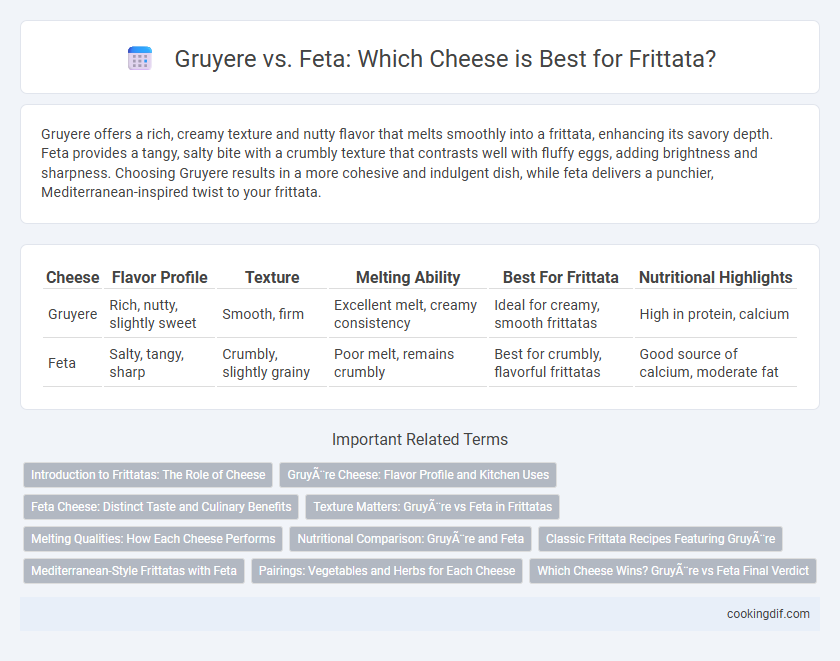Gruyere offers a rich, creamy texture and nutty flavor that melts smoothly into a frittata, enhancing its savory depth. Feta provides a tangy, salty bite with a crumbly texture that contrasts well with fluffy eggs, adding brightness and sharpness. Choosing Gruyere results in a more cohesive and indulgent dish, while feta delivers a punchier, Mediterranean-inspired twist to your frittata.
Table of Comparison
| Cheese | Flavor Profile | Texture | Melting Ability | Best For Frittata | Nutritional Highlights |
|---|---|---|---|---|---|
| Gruyere | Rich, nutty, slightly sweet | Smooth, firm | Excellent melt, creamy consistency | Ideal for creamy, smooth frittatas | High in protein, calcium |
| Feta | Salty, tangy, sharp | Crumbly, slightly grainy | Poor melt, remains crumbly | Best for crumbly, flavorful frittatas | Good source of calcium, moderate fat |
Introduction to Frittatas: The Role of Cheese
Gruyere and feta both bring distinctive flavors and textures to a frittata, enhancing the egg base with rich creaminess or tangy sharpness. Gruyere melts smoothly, offering a nutty, slightly sweet profile that complements vegetables and herbs, while feta provides a crumbly, salty contrast that brightens the dish. Selecting the right cheese influences the frittata's taste intensity and mouthfeel, making cheese a pivotal ingredient in achieving the perfect balance in this versatile egg casserole.
Gruyère Cheese: Flavor Profile and Kitchen Uses
Gruyere cheese offers a rich, nutty flavor with a slightly sweet and salty profile that melts smoothly, making it ideal for enhancing the texture and taste of frittatas. Its firm yet creamy consistency allows it to blend seamlessly with eggs, creating a luscious, savory base that complements vegetables and herbs. Known for its excellent melting properties and depth of flavor, Gruyere elevates frittatas to a gourmet level, contrasting with feta's crumbly texture and tangier taste.
Feta Cheese: Distinct Taste and Culinary Benefits
Feta cheese offers a distinct tangy and salty flavor that enhances the overall taste profile of a frittata, creating a vibrant and Mediterranean-inspired dish. Its crumbly texture allows for even distribution throughout the eggs, providing bursts of savory richness in every bite. Unlike Gruyere's creamy melt, feta retains some firmness when cooked, adding a unique contrast that complements fresh vegetables and herbs.
Texture Matters: Gruyère vs Feta in Frittatas
Gruyere offers a creamy, smooth texture that melts evenly, creating a rich and cohesive frittata, while feta provides a crumbly, tangy bite that adds sharpness and distinct pockets of flavor. Choosing Gruyere results in a silky, velvety mouthfeel, ideal for those who prefer a uniform cheese consistency. In contrast, feta's crumbly texture introduces a rustic contrast that complements eggs with bursts of saltiness throughout the dish.
Melting Qualities: How Each Cheese Performs
Gruyere melts smoothly into a creamy, rich texture, creating a velvety consistency that complements the eggs in a frittata. Feta, on the other hand, retains its crumbly structure and adds a tangy punch, offering pockets of bold flavor rather than a homogenous melt. Choosing Gruyere enhances the frittata's silky mouthfeel, while feta provides distinctive bursts of salty sharpness without fully melting.
Nutritional Comparison: Gruyère and Feta
Gruyere cheese offers higher calcium and protein content per serving compared to feta, supporting bone health and muscle maintenance. Feta contains fewer calories and less fat, making it a lighter option suitable for calorie-conscious diets. Both cheeses provide essential vitamins like B12 and riboflavin, but their distinct nutritional profiles influence the overall health benefits of a frittata.
Classic Frittata Recipes Featuring Gruyère
Gruyere cheese enhances classic frittata recipes with its rich, nutty flavor and smooth melting properties, creating a creamy texture that complements eggs perfectly. Compared to feta, which offers a tangy and crumbly contrast, Gruyere provides a more cohesive and indulgent bite, ideal for traditional Italian or French-style frittatas. Recipes featuring Gruyere often incorporate ingredients like spinach, mushrooms, and herbs, maximizing the cheese's ability to blend seamlessly while adding depth to the overall dish.
Mediterranean-Style Frittatas with Feta
Feta cheese brings a tangy, salty flavor that perfectly complements Mediterranean-style frittatas, enhancing ingredients like spinach, tomatoes, and olives. Its crumbly texture melts slightly without becoming too creamy, maintaining the light and fresh character typical of Mediterranean cuisine. Compared to Gruyere, which offers a rich, nutty taste and creamy melt, feta highlights the bright, savory profiles essential to authentic Mediterranean frittatas.
Pairings: Vegetables and Herbs for Each Cheese
Gruyere pairs exceptionally well with earthy vegetables like mushrooms, spinach, and leeks, enhancing the frittata with its nutty, creamy flavor, while fresh herbs such as thyme, chives, and parsley complement its richness perfectly. Feta provides a tangy, salty contrast that brightens ingredients like tomatoes, zucchini, and bell peppers, with Mediterranean herbs like oregano, dill, and basil boosting its vibrant profile. Choosing between Gruyere and feta depends on the desired flavor complexity and vegetable-herb combinations to create a balanced, delicious frittata.
Which Cheese Wins? Gruyère vs Feta Final Verdict
Gruyere offers a creamy, nutty flavor that melts smoothly, enhancing the texture of a frittata with rich, harmonious notes. Feta provides a tangy, salty punch and crumbly texture that adds a bold contrast but may not blend as uniformly. For a well-balanced, melt-in-your-mouth frittata, Gruyere often wins, while feta suits those seeking a sharper, more distinct cheese profile.
Gruyère vs feta for frittata cheese Infographic

 cookingdif.com
cookingdif.com